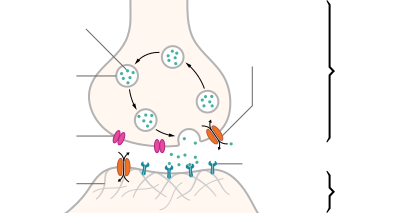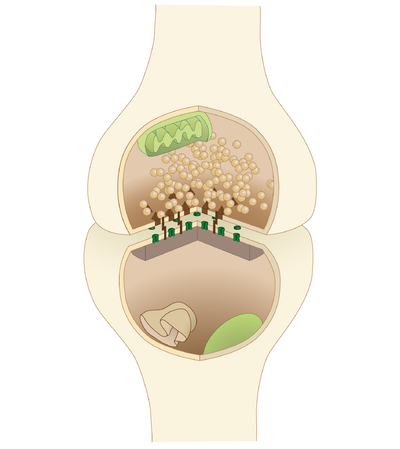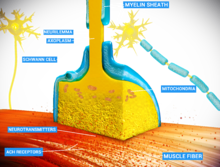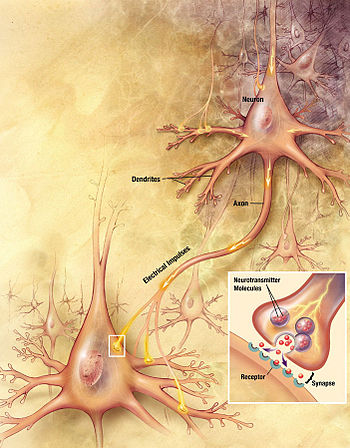| Dendritic spine | |
|---|---|

Spiny dendrite of a striatal medium spiny neuron.
| |
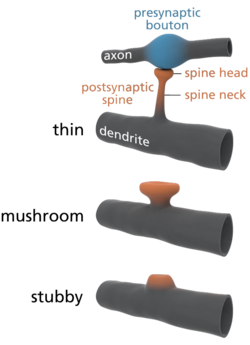
Common types of dendritic spines.
| |
| Details | |
| Identifiers | |
| Latin | gemmula dendritica |
| MeSH | D049229 |
| TH | H2.00.06.1.00036 |
A dendritic spine (or spine) is a small membranous protrusion from a neuron's dendrite that typically receives input from a single axon at the synapse. Dendritic spines serve as a storage site for synaptic strength and help transmit electrical signals to the neuron's cell body. Most spines have a bulbous head (the spine head), and a thin neck that connects the head of the spine to the shaft of the dendrite. The dendrites of a single neuron can contain hundreds to thousands of spines. In addition to spines providing an anatomical substrate for memory storage and synaptic transmission, they may also serve to increase the number of possible contacts between neurons.
Structure
Dendritic spines are small with spine head volumes ranging 0.01 μm3 to 0.8 μm3.
Spines with strong synaptic contacts typically have a large spine head,
which connects to the dendrite via a membranous neck. The most notable
classes of spine shape are "thin", "stubby", "mushroom", and "branched".
Electron microscopy
studies have shown that there is a continuum of shapes between these
categories. The variable spine shape and volume is thought to be
correlated with the strength and maturity of each spine-synapse.
Distribution
Dendritic spines usually receive excitatory input
from axons, although sometimes both inhibitory and excitatory
connections are made onto the same spine head. Excitatory axon proximity
to dendritic spines is not sufficient to predict the presence of a
synapse, as demonstrated by the Lichtman lab in 2015.
Spines are found on the dendrites of most principal neurons in the brain, including the pyramidal neurons of the neocortex, the medium spiny neurons of the striatum, and the Purkinje cells of the cerebellum. Dendritic spines occur at a density of up to 5 spines/1 μm stretch of dendrite. Hippocampal and cortical pyramidal neurons may receive tens of thousands of mostly excitatory inputs from other neurons onto their equally numerous spines, whereas the number of spines on Purkinje neuron dendrites is an order of magnitude larger.
Cytoskeleton and organelles
The
cytoskeleton of dendritic spines is particularly important in their
synaptic plasticity; without a dynamic cytoskeleton, spines would be
unable to rapidly change their volumes or shapes in responses to
stimuli. These changes in shape might affect the electrical properties
of the spine. The cytoskeleton of dendritic spines is primarily made of
filamentous actin (F-actin). tubulin Monomers and microtubule-associated proteins (MAPs) are present, and organized microtubules are present. Because spines have a cytoskeleton of primarily actin, this allows them
to be highly dynamic in shape and size. The actin cytoskeleton directly
determines the morphology of the spine, and actin regulators, small GTPases such as Rac, RhoA, and CDC42, rapidly modify this cytoskeleton. Overactive Rac1 results in consistently smaller dendritic spines.
In addition to their electrophysiological activity and their
receptor-mediated activity, spines appear to be vesicularly active and
may even translate proteins. Stacked discs of the smooth endoplasmic reticulum (SERs) have been identified in dendritic spines. Formation of this "spine apparatus" depends on the protein synaptopodin and is believed to play an important role in calcium handling. "Smooth" vesicles have also been identified in spines, supporting the vesicular activity in dendritic spines. The presence of polyribosomes in spines also suggests protein translational activity in the spine itself, not just in the dendrite.
Physiology
Receptor activity
Dendritic spines express glutamate receptors (e.g. AMPA receptor and NMDA receptor) on their surface. The TrkB receptor for BDNF
is also expressed on the spine surface, and is believed to play a role
in spine survival. The tip of the spine contains an electron-dense
region referred to as the "postsynaptic density" (PSD). The PSD directly apposes the active zone
of its synapsing axon and comprises ~10% of the spine's membrane
surface area; neurotransmitters released from the active zone bind
receptors in the postsynaptic density of the spine. Half of the
synapsing axons and dendritic spines are physically tethered by calcium-dependent cadherin, which forms cell-to-cell adherent junctions between two neurons.
Glutamate receptors (GluRs) are localized to the postsynaptic
density, and are anchored by cytoskeletal elements to the membrane. They
are positioned directly above their signalling machinery, which is
typically tethered to the underside of the plasma membrane, allowing
signals transmitted by the GluRs into the cytosol to be further propagated by their nearby signalling elements to activate signal transduction cascades.
The localization of signalling elements to their GluRs is particularly
important in ensuring signal cascade activation, as GluRs would be
unable to affect particular downstream effects without nearby
signallers.
Signalling from GluRs is mediated by the presence of an abundance
of proteins, especially kinases, that are localized to the postsynaptic
density. These include calcium-dependent calmodulin, CaMKII (calmodulin-dependent protein kinase II), PKC (Protein Kinase C), PKA (Protein Kinase A), Protein Phosphatase-1 (PP-1), and Fyn tyrosine kinase. Certain signallers, such as CaMKII, are upregulated in response to activity.
Spines are particularly advantageous to neurons by
compartmentalizing biochemical signals. This can help to encode changes
in the state of an individual synapse without necessarily affecting the
state of other synapses of the same neuron. The length and width of the
spine neck has a large effect on the degree of compartmentalization,
with thin spines being the most biochemically isolated spines.
Plasticity
Dendritic spines are very "plastic", that is, spines change
significantly in shape, volume, and number in small time courses.
Because spines have a primarily actin cytoskeleton, they are dynamic, and the majority of spines change their shape within seconds to minutes because of the dynamicity of actin remodeling.
Furthermore, spine number is very variable and spines come and go; in a
matter of hours, 10-20% of spines can spontaneously appear or disappear
on the pyramidal cells of the cerebral cortex, although the larger
"mushroom"-shaped spines are the most stable.
Spine maintenance and plasticity is activity-dependent and activity-independent. BDNF partially determines spine levels, and low levels of AMPA receptor activity is necessary to maintain spine survival, and synaptic activity involving NMDA receptors encourages spine growth. Furthermore, two-photon laser scanning microscopy and confocal microscopy have shown that spine volume changes depending on the types of stimuli that are presented to a synapse.
Importance to learning and memory
Evidence of importance
Experience-dependent spine formation and elimination
Spine plasticity is implicated in motivation, learning, and memory. In particular, long-term memory
is mediated in part by the growth of new dendritic spines (or the
enlargement of pre-existing spines) to reinforce a particular neural
pathway. Because dendritic spines are plastic structures whose lifespan
is influenced by input activity, spine dynamics may play an important role in the maintenance of memory over a lifetime.
Age-dependent changes in the rate of spine turnover suggest that
spine stability impacts developmental learning. In youth, dendritic
spine turnover is relatively high and produces a net loss of spines.
This high rate of spine turnover may characterize critical periods of
development and reflect learning capacity in adolescence—different
cortical areas exhibit differing levels of synaptic turnover during
development, possibly reflecting varying critical periods for specific brain regions. In adulthood, however, most spines remain persistent, and the half-life of spines increases.
This stabilization occurs due to a developmentally regulated slow-down
of spine elimination, a process which may underlie the stabilization of
memories in maturity.
Experience-induced changes in dendritic spine stability also
point to spine turnover as a mechanism involved in the maintenance of
long-term memories, though it is unclear how sensory experience affects
neural circuitry. Two general models might describe the impact of
experience on structural plasticity. On the one hand, experience and
activity may drive the discrete formation of relevant synaptic
connections that store meaningful information in order to allow for
learning. On the other hand, synaptic connections may be formed in
excess, and experience and activity may lead to the pruning of
extraneous synaptic connections.
In lab animals of all ages, environmental enrichment has been
related to dendritic branching, spine density, and overall number of
synapses.
In addition, skill training has been shown to lead to the formation and
stabilization of new spines while destabilizing old spines,
suggesting that the learning of a new skill involves a rewiring process
of neural circuits. Since the extent of spine remodeling correlates
with success of learning, this suggests a crucial role of synaptic
structural plasticity in memory formation. In addition, changes in spine stability and strengthening occur rapidly and have been observed within hours after training.
Conversely, while enrichment and training are related to increases in spine formation and stability, long-term sensory deprivation leads to an increase in the rate of spine elimination
and therefore impacts long-term neural circuitry. Upon restoring
sensory experience after deprivation in adolescence, spine elimination
is accelerated, suggesting that experience plays an important role in
the net loss of spines during development.
In addition, other sensory deprivation paradigms—such as whisker
trimming—have been shown to increase the stability of new spines.
Research in neurological diseases and injuries shed further light on the nature and importance of spine turnover. After stroke,
a marked increase in structural plasticity occurs near the trauma site,
and a five- to eightfold increase from control rates in spine turnover
has been observed. Dendrites disintegrate and reassemble rapidly during ischemia—as with stroke, survivors showed an increase in dendritic spine turnover. While a net loss of spines is observed in Alzheimer's disease and cases of intellectual disability, cocaine and amphetamine use have been linked to increases in dendritic branching and spine density in the prefrontal cortex and the nucleus accumbens.
Because significant changes in spine density occur in various brain
diseases, this suggests a balanced state of spine dynamics in normal
circumstances, which may be susceptible to disequilibrium under varying
pathological conditions.
There is also some evidence for loss of dendritic spines as a
consequence of aging. One study using mice has noted a correlation
between age-related reductions in spine densities in the hippocampus and
age-dependent declines in hippocampal learning and memory.
Importance contested
Despite
experimental findings that suggest a role for dendritic spine dynamics
in mediating learning and memory, the degree of structural plasticity's
importance remains debatable. For instance, studies estimate that only a
small portion of spines formed during training actually contribute to
lifelong learning.
In addition, the formation of new spines may not significantly
contribute to the connectivity of the brain, and spine formation may not
bear as much of an influence on memory retention as other properties of
structural plasticity, such as the increase in size of spine heads.
Modeling
Theoreticians
have for decades hypothesized about the potential electrical function
of spines, yet our inability to examine their electrical properties has
until recently stopped theoretical work from progressing too far. Recent
advances in imaging techniques along with increased use of two-photon
glutamate uncaging have led to a wealth of new discoveries; we now
suspect that there are voltage-dependent sodium, potassium, and calcium channels in the spine heads.
Cable theory
provides the theoretical framework behind the most "simple" method for
modelling the flow of electrical currents along passive neural fibres.
Each spine can be treated as two compartments, one representing the
neck, the other representing the spine head. The compartment
representing the spine head alone should carry the active properties.
Baer and Rinzel's continuum model
To
facilitate the analysis of interactions between many spines, Baer &
Rinzel formulated a new cable theory for which the distribution of
spines is treated as a continuum.
In this representation, spine head voltage is the local spatial average
of membrane potential in adjacent spines. The formulation maintains the
feature that there is no direct electrical coupling between neighboring
spines; voltage spread along dendrites is the only way for spines to
interact.
Spike-diffuse-spike model
The SDS model was intended as a computationally simple version of the full Baer and Rinzel model.
It was designed to be analytically tractable and have as few free
parameters as possible while retaining those of greatest significance,
such as spine neck resistance. The model drops the continuum
approximation and instead uses a passive dendrite coupled to excitable
spines at discrete points. Membrane dynamics in the spines are modelled
using integrate and fire processes. The spike events are modelled in a
discrete fashion with the wave form conventionally represented as a
rectangular function.
Modeling spine calcium transients
Calcium transients in spines are a key trigger for synaptic plasticity. NMDA receptors,
which have a high permeability for calcium, only conduct ions if the
membrane potential is suffiently depolarized. The amount of calcium
entering a spine during synaptic activity therefore depends on the
depolarization of the spine head. Evidence from calcium imaging
experiments (two-photon microscopy) and from compartmental modelling indicates that spines with high resistance necks experience larger calcium transients during synaptic activity.
Development
Dendritic spines can develop directly from dendritic shafts or from dendritic filopodia. During synaptogenesis,
dendrites rapidly sprout and retract filopodia, small membrane
organelle-lacking membranous protrusions. Recently, I-BAR protein MIM
was found to contribute to the initiation process.
During the first week of birth, the brain is predominated by filopodia,
which eventually develop synapses. However, after this first week,
filopodia are replaced by spiny dendrites but also small, stubby spines
that protrude from spiny dendrites. In the development of certain
filopodia into spines, filopodia recruit presynaptic contact to the
dendrite, which encourages the production of spines to handle
specialized postsynaptic contact with the presynaptic protrusions.
Spines, however, require maturation after formation. Immature
spines have impaired signaling capabilities, and typically lack "heads"
(or have very small heads), only necks, while matured spines maintain
both heads and necks.
Clinical significance
Cognitive disorders such as ADHD, autism, intellectual disability, and fragile X syndrome, may be resultant from abnormalities in dendritic spines, especially the number of spines and their maturity.
The ratio of matured to immature spines is important in their
signaling, as immature spines have impaired synaptic signaling. Fragile X
syndrome is characterized by an overabundance of immature spines that
have multiple filopodia in cortical dendrites.
History
Dendritic spines were first described at the end of the 19th century by Santiago Ramón y Cajal on cerebellar neurons.
Ramón y Cajal then proposed that dendritic spines could serve as
contacting sites between neurons. This was demonstrated more than 50
years later thanks to the emergence of electron microscopy.
Until the development of confocal microscopy on living tissues, it was
commonly admitted that spines were formed during embryonic development
and then would remain stable after birth. In this paradigm, variations
of synaptic weight were considered as sufficient to explain memory
processes at the cellular level. But since about a decade ago, new
techniques of confocal microscopy demonstrated that dendritic spines are
indeed motile and dynamic structures that undergo a constant turnover,
even after birth.


